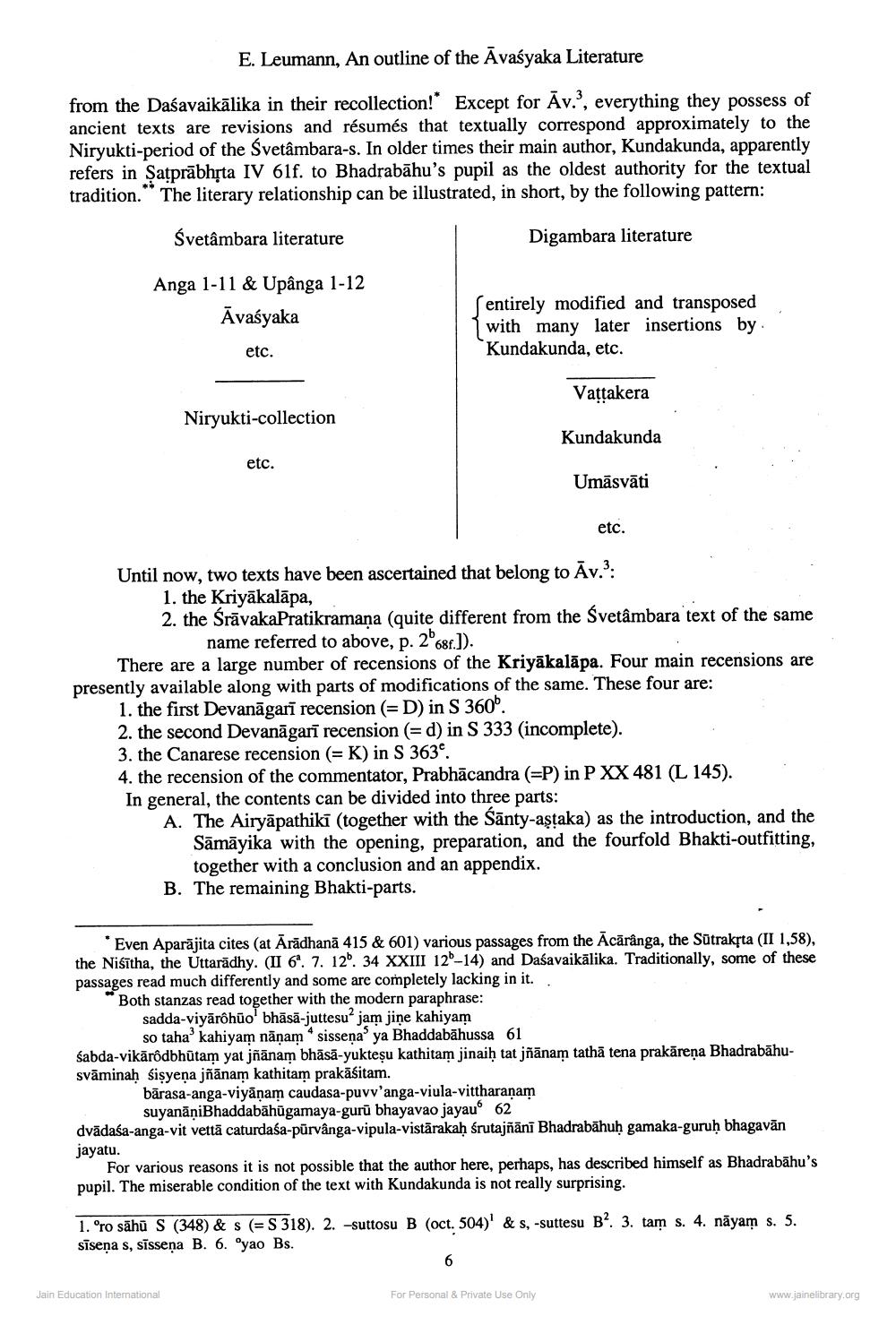________________
E. Leumann, An outline of the Avaśyaka Literature
from the Daśavaikālika in their recollection!* Except for Av.3, everything they possess of ancient texts are revisions and résumés that textually correspond approximately to the Niryukti-period of the Svetâmbara-s. In older times their main author, Kundakunda, apparently refers in Satprabhṛta IV 61f. to Bhadrabahu's pupil as the oldest authority for the textual tradition. The literary relationship can be illustrated, in short, by the following pattern:
Śvetâmbara literature
Digambara literature
Anga 1-11 & Upânga 1-12
Avaśyaka
etc.
Niryukti-collection
etc.
entirely modified and transposed with many later insertions by Kundakunda, etc.
Vaṭṭakera
Kundakunda
Until now, two texts have been ascertained that belong to Av.3:
1. the Kriyakalāpa,
2. the ŚravakaPratikramana (quite different from the Svetâmbara text of the same name referred to above, p. 2b 68f.]).
There are a large number of recensions of the Kriyakalapa. Four main recensions are presently available along with parts of modifications of the same. These four are:
1. the first Devanagarī recension (=D) in S 360°.
2. the second Devanagarī recension (= d) in S 333 (incomplete).
3. the Canarese recension (= K) in S 363°.
4. the recension of the commentator, Prabhācandra (=P) in P XX 481 (L 145).
In general, the contents can be divided into three parts:
A. The Airyapathiki (together with the Santy-aṣṭaka) as the introduction, and the Sāmāyika with the opening, preparation, and the fourfold Bhakti-outfitting, together with a conclusion and an appendix.
B. The remaining Bhakti-parts.
Jain Education International
Umāsvāti
Even Aparajita cites (at Aradhana 415 & 601) various passages from the Acarânga, the Sütrakṛta (II 1,58), the Niśītha, the Uttaradhy. (II 6. 7. 12. 34 XXIII 12-14) and Daśavaikālika. Traditionally, some of these passages read much differently and some are completely lacking in it.
etc.
Both stanzas read together with the modern paraphrase:
sadda-viyārôhūo1 bhāsā-juttesu2 jam jine kahiyam
so taha kahiyam nāṇam sisseṇa ya Bhaddabāhussa 61
śabda-vikārôdbhūtam yat jñānam bhāsā-yukteṣu kathitam jinaiḥ tat jñānam tathā tena prakāreņa Bhadrabahusvaminaḥ śisyena jñānam kathitam prakāśitam.
barasa-anga-viyāṇam caudasa-puvv'anga-viula-vittharanam suyanāṇiBhaddabahūgamaya-guru bhayavao jayau 62
dvādasa-anga-vit vettä caturdaśa-pūrvânga-vipula-vistārakaḥ śrutajñānī Bhadrabahuḥ gamaka-guruḥ bhagavan jayatu.
For various reasons it is not possible that the author here, perhaps, has described himself as Bhadrabahu's pupil. The miserable condition of the text with Kundakunda is not really surprising.
6
1. °ro sähū S (348) & s (= S 318). 2. -suttosu B (oct. 504)' & s, -suttesu B2. 3. tam s. 4. nayam s. 5. sīseņa s, sīsseņa B. 6. yao Bs.
For Personal & Private Use Only
www.jainelibrary.org




